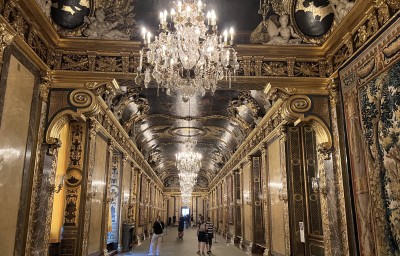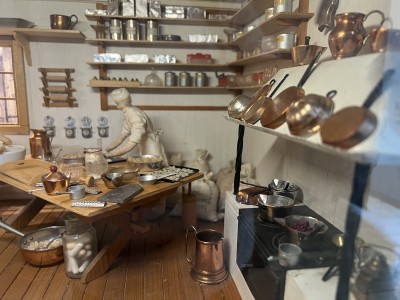Museums in Sweden: from Ship wrecks to Nobel Prize to ABBA

Warship Vasa sank in 1628.
Vasa Museum
The Vasa Museum holds the relic of a trophy ship, built for King Gustav II Adolf (1594-1632) that sank in 1628 after travelling only 1300 meters. When you first set eyes upon this ship, you can only gasp in wonder. Its masts are errected at a height that shows the true level that the ship would float in the sea.

The ship was top-heavy and the design was flawed. There was not sufficent ballast.

Model of the Vasa
In 1959, 333 years later, the ship was lifted from the mud of the Baltic Sea. But first it needed to be dried out to avoid decay. This involved a complex regime of waiting and spraying along with controlling the ambient temperature and humidity. It is now housed in a purpose-built museum.

Model of the Vasa as it sinks.
Human remains were found in the wreckage. Technology has been used to re-create the stories of the victims in dramatic detail. From isolating broken limbs, to cause of death, past illness even family resemblances. The victim stories have been reconstructed with surprising detail.
Museum of Wrecks
The Vrak - Museum of Wrecks, offers a compelling journey through a number of famous ship wrecks that lie at the bottom of the Baltic Sea. With the help of advanced technology, marine archaeologists are now able to photograph and map wrecks on the seafloor, creating a 3D model of the entire wreck site. You can see visuals of wrecks, essentially frozen at a moment of time.

The brackish nature of the Baltic Sea, where it has more salinity than freshwater, but not as much as seawater, better preserves the timbers of a sunk vessels. Shipworms that attack the timber do not thrive in the Baltic Sea. In addition, the Baltic Sea is not deep with a maximum depth of 459 m (1,506 ft). Tides are small and reach 17 to 19 cm in the Gulf of Finland compared with around Auckland where the tidal range, depending on the period of the lunar cycle, can be between 80 cm to 3.5 metres.

At the Museum of Wrecks, you can learn of the ship, Resande Man, that sank in the Stockholm archipelago in 1660. It was sailing to Poland on an important diplomatic mission and one of the survivors, Secretary Andreas Bjugg, vividly described the dramatic shipwreck.
The Vrouw Maria, a Dutch wooden, two-masted merchant ship carrying a valuable cargo including artwork for Catherine the Great, sank in 1771 and was discovered in 1991.
MS Estonia sank 1994

There is a haunting display about the sinking of the cruise ferry, MS Estonia in 1994, where 852 people died and 138 were rescued. It includes digital text and audio recordings of the communication following the mayday call of MS Estonia to nearby ships.
The cause of the sinking was attributed to a heavy wave hitting the bow doors which eventually tore open allowing seawater to flood into the car deck causing the ship to list. It sank within 30 minutes of the mayday call. By the time the rescue ships arrived, there were only lights from lifeboats to be seen.

Alice Hay at ABBA The Museum
Abba The Museum
A visit to Stockholm, should include time to explore ABBA The Museum, created to celebrate the sensational 1970s Swedish pop group. Their motto: Walk in. Dance out. 
From viewing the concert outfits to detailed audio interviews with the band or having-a-go conducting the orchestra of the musical CHESS or just singing a long.
Even my daughter Alice, knows all the songs. Classics such as The Winner Takes It All; Dancing Queen; Take a Chance on Me; Waterloo...when Napoleon did surrender...

Nobel Prize Museum
The Nobel Prize Museum honours the recipients of these awards, the legacy of Alfred Nobel created in 1901 for Physics, Chemistry, Medicine, Literature, Peace and Economic Science.

Alfred Nobel was born in Stockholm in 1833. His father, Immanuel was an engineer and inventor who built bridges and buildings and used different techniques for blasting rocks. In the same year that Alfred was born, his father’s business was placed into bankruptcy.
The family later moved to St. Petersburg, Russia. Immanuel Nobel set up a new business which included the manufacture of simple explosive devices - submerged wooden casks filled with gunpowder. Here, he convinced the Tsar and his generals that naval mines could be used to block enemy ships (namely the British) from attacking Russia during the Crimea War of 1853-56.
In St. Petersburg, Immanuel’s sons were given a first class education including natural sciences, languages and literature. To widen his horizons, Alfred was sent abroad to learn about chemical engineering. He visited Sweden, Germany, France and USA and became very interested in nitroglycerine and how it could be used as an explosive in construction.

Over the next period, there was much experimentation with nitroglycerine but with tragic consequences as Alfred’s brother and others were accidentally killed.
During the 1867, Alfred Nobel obtained patents for his invention of dynamite which rapidly gained an international market for explosives. Read more about Alfred Nobel.
This is how Alfred Nobel made his fortune and the legacy that we know today as the Nobel Prize. Read more about Nobel Laureats. The musuem is full of interesting displays, videos, memorabilia about outstanding awardees.


Marie Curie at work
Marie Curie Nobel Prize 1906 and 1911
Marie Salomea Skłodowska–Curie (1867-1934) was born in Poland but spent her adult life in France working as a physicist and chemist. In 1903, Marie Curie and her husband Pierre, were awarded the Nobel Prize for Physics for their pioneering research on radioactivity. In 1906, Marie Curie was the first woman conferred as professor at the University of Paris.
In 1911, Marie Curie was awarded the Nobel Prize in Chemistry. This was in recognition of her discovery of polonium (named after her native country, Poland) and radium.

Marie Curie's Desk

Royal Palace Museum Kungliga Slottet
The Royal Palace Museum is the official residence of the Swedish Royal Family and and is open to the public.
The Council Chamber

Swedish Kungshomen Glassware (1676-1815)

Karl XI's Gallery inspired by Hall of Mirrors at Versailles. Banquets were served at a long table for up to 170 guests.
Jean-Baptiste Bernadotte (1763-1844) was a French Marshall under Napoleon. In 1810 he was elected heir-presumptive to childless King Charles XIII of Sweden and Norway. He was crowned Charles III John in 1818. The House of Bernadotte remain in power to this day.
And there are many more...
The Viking Museum, located near to ABBA The Museum.

For the Vikings, their diet consisted of porridge and bread made from barley, ground by hand. Some was fermented into beer. Cows provided milk and butter, meat. Foraged herbs, roots, berries and nuts provided other nourishment.
Museum of Gothenburg

A Bakery 'Dollshouse' c1950.
We also discovered a World in Miniature at the outstanding Museum of Gothenburg.

Created by artist Signhild Haller in the 1950s. She worked with a scale of 1:10.
Celia Hay
27 July 2023








